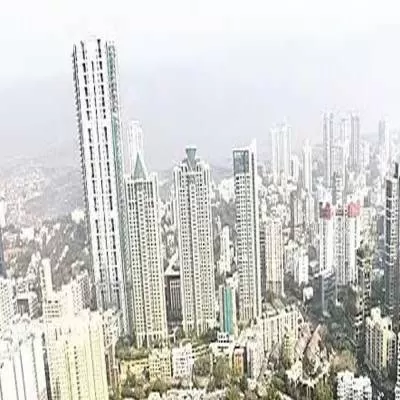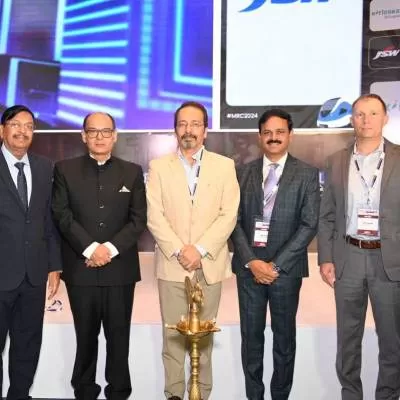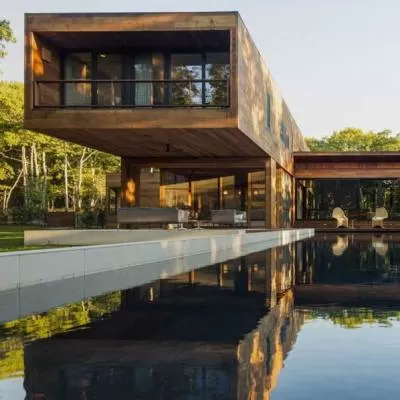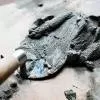- Home
- Real Estate
- Top of the block
Top of the block
Across the globe, especially in countries like the UK and Germany, the use of autoclaved aerated concrete (AAC) blocks accounts for 40 per cent and 60 per cent of construction, respectively. India is also catching up. As of today, the Indian market for AAC blocks, which is pegged at Rs 500 crore, has seen an increase in demand leading to an increase in production by almost 500 per cent. In fact, AAC blocks could be rightly termed amongst the most innovative building materials of the century.
The preparation
The manufacturing process of AAC blocks is carried out with great expertise. They are formed as a reaction of aluminium metal with blended proportions of lime, cement, gypsum and fly-ash. Owing to the reaction, hydrogen gas is generated; as the gas escapes, it inflates the material to 200 per cent, making it lightweight. Sourabh Bansal, Co-Founder, Magicrete, says, "The core component of the material comprises 70 per cent fly-ash and the remaining 30 per cent is a blend of around six to seven raw materials serving as binders and additives." He further mentions that all ingredients are combined in a liquid state and cast into a mould. Following this, the mixture is allowed to cool for a few hours, which solidifies it; it is cut into various sizes and sent into 'autoclave'- a high pressure vessel where curing is done. In the autoclaving process, high-pressure steam is generated that penetrates the innermost pore of the mixture, thus strengthening the material from inside; it is cured at high pressure for 12 hours.
Uses and applications
AAC blocks comprise 80 per cent air; owing to their honeycomb structure, they are light in weight. They play a vital role in wall construction, especially in high-rise buildings such as residential and commercial complexes, malls, hotels and hospitals. And in the case of low storied structures up to G + two, they can also be utilised as a load bearing wall. Beam column structures can also be created with the assistance of these blocks. Some projects that have used this material include leading hotels such as ITC, Marriott, The Leela; Lodha Bellisimo and Wockhardt hospital in Mumbai; Tapti Valley International School in Surat; Princess Business Park in Indore; and Atlantis in Vadodara. Globally, prominent structures that have been created by these blocks include The Palm, Al Burj, Emirates Palace, Dubai Marina in Dubai; Four Seasons hotel in China; Royal Crescent Flats in London; One Central Park in Sydney and so on.
The green factor
The real estate segment has now become increasingly conscious about sustainability. Indeed, AAC blocks are eco-friendly in nature, as Jayakrishnan, General Manager, Aerocon Business, highlights, "In today's world, there has been a lot of emphasis on using green building materials in structures. Agencies such as GRIHA and LEED also provide green building ratings to structures that make use of sustainable materials and AAC is one such green material." The use of AAC blocks contributes to at least three to four points in the LEED rating system. Bansal, shares the three prime reasons that make AAC blocks amongst the greenest of materials. "First,
fly- ash, a proportion of which is used to produce these blocks, is a national waste. Second, AAC blocks consume five times lesser energy than clay bricks. Last, during their lifecycle, they continuously save on energy, which in turn saves on HVAC and air-conditioning costs." All these together help reduce the carbon footprint compared to any other conventional walling material.
The numbers game
The cost of these blocks varies across diverse regions. "Initially, the cost was 25-30 per cent higher than clay bricks but today it has reached parity. In Mumbai, bricks cost anywhere between Rs 6 and Rs 7 per unit," says Bansal. "For instance, in 1 cu m, which comprises about 600 bricks, the cost is around Rs 4,000 per cu m. However, AAC blocks are available at a price range of around Rs 3,800-4,000 per cu m." Also, the material's thermal insulation properties reduce air-conditioning costs by 25-30 per cent. There is also a 15-20 per cent savings in structural components such as steel and concrete.
On the other hand, Sheetal Rakheja, Director, Design and Development (Architects for The 3C Company) provides a different perspective regarding the cost factor in the North. She elaborates, "In the North, the installed cost of 1 cu m of AAC blocks is approximately Rs 6,800 while the installed cost of 1 cu m of red brick is approximately Rs 5,800. Builders still prefer using AAC blocks considering the numerous benefits it offers. Although, the major hurdle stopping the industry to completely switch to AAC blocks is its limited availability." To this, Jayakrishnan adds, "The use of AAC blocks leads to savings in overall project cost." Thus, it is a win-win situation for developers, end users and even con¡tractors as it enables them to speed up the construction process.
In comparison
If steel and cement are two important building materials, bricks are the third most consumed material in India. "There are around 1 lakh clay brick manufacturers existing across India," says Bansal. "However, the method of manufacturing these bricks is inefficient as a large land spread is wasted in the process; the top layer of the agricultural soil is excavated, further damaging the land. Compared to clay bricks, AAC blocks are 10 times larger and 70 per cent lighter." Jayakrishnan adds, "They are factory made and their size helps to speed up construction unlike clay bricks."
The challenges
Replacing a 1,000 year-old material with a new one did not find many takers. Bansal shares his experience: "It was difficult to convince builders who are not open to experimenting with new materials in their structures. Hence, we had to set up a couple of demonstration projects." Also, availability is still a challenge. "AAC blocks are easily available in the southern and western regions of the country," says Jayakrishnan. "They are also slowly gaining popularity in the North and demand is growing in Tier-II cities as well. However, the material is not easily available here."
The Indian market
Having said that, the material has now seen tremendous acceptance amongst a vast range of developers, such as L&T, Lodha, Shapoorji Pallonji, Kanakia, Rustomjee, Raheja, Ahluwalia Contractors, Westcon, Mantri Developers, Embassy Group, etc. "The AAC blocks industry has grown in five years from a Rs 50 crore to a Rs 500 crore industry," concludes Bansal. "And in the next five years, it is expected to be a Rs 5,000 crore industry."
CASE STUDY 1:
Project: Rahul Raj Mall, Surat
Cost analysis RCC cost: Reduced by 8-10 per cent.
Other materials and labour cost: Mortar and plaster cost reduced up to 15 per cent.
Time saving: Wall was constructed in half the time.
UserSpeak: "The use of AAC blocks ensured a better wall surface in comparison to brick walls. These blocks are available in different sizes which provide flexibility in choice," Vimal Vaniwala, Partner, Harsh Constructions, says, further adding,"Also, due to its large size, it helps to enhance the speed of work and reduce wastage, thus saving the cost of construction."
CASE STUDY 2:
Project: Lotus Boulevard, Noida
Construction area: 5,935,594 sq ft
Cost analysis: RCC Cost: Reduced by 3 per cent of total structural cost
Time saving: Savings of 20 per cent as compared to conventional construction.
UserSpeak: "AAC blocks are a viable replacement for conventional red clay bricks. It is manufactured through a process, which is less energy intensive and polluting as compared to the thermal baking process used for manufacturing fired clay bricks," says Sheetal Rakheja, Director, Design and Development (Architects for The 3C Company), adding, "In addition, AAC blocks utilise fly-ash, which is an industrial waste. In this project, AAC blocks have been extensively used for all external and internal walls. They are not only light weight, but also reduce structural load and provide thermal insulation."
To share your insight on interesting construction materials, write in at feedback@ASAPPmedia.com
Utilising traditional red bricks in the construction of buildings is now passé; a new and improved alternate to bricks - AAC blocks - is here, AHLAM RAIS reports. Across the globe, especially in countries like the UK and Germany, the use of autoclaved aerated concrete (AAC) blocks accounts for 40 per cent and 60 per cent of construction, respectively. India is also catching up. As of today, the Indian market for AAC blocks, which is pegged at Rs 500 crore, has seen an increase in demand leading to an increase in production by almost 500 per cent. In fact, AAC blocks could be rightly termed amongst the most innovative building materials of the century. The preparation The manufacturing process of AAC blocks is carried out with great expertise. They are formed as a reaction of aluminium metal with blended proportions of lime, cement, gypsum and fly-ash. Owing to the reaction, hydrogen gas is generated; as the gas escapes, it inflates the material to 200 per cent, making it lightweight. Sourabh Bansal, Co-Founder, Magicrete, says, "The core component of the material comprises 70 per cent fly-ash and the remaining 30 per cent is a blend of around six to seven raw materials serving as binders and additives." He further mentions that all ingredients are combined in a liquid state and cast into a mould. Following this, the mixture is allowed to cool for a few hours, which solidifies it; it is cut into various sizes and sent into 'autoclave'- a high pressure vessel where curing is done. In the autoclaving process, high-pressure steam is generated that penetrates the innermost pore of the mixture, thus strengthening the material from inside; it is cured at high pressure for 12 hours. Uses and applications AAC blocks comprise 80 per cent air; owing to their honeycomb structure, they are light in weight. They play a vital role in wall construction, especially in high-rise buildings such as residential and commercial complexes, malls, hotels and hospitals. And in the case of low storied structures up to G + two, they can also be utilised as a load bearing wall. Beam column structures can also be created with the assistance of these blocks. Some projects that have used this material include leading hotels such as ITC, Marriott, The Leela; Lodha Bellisimo and Wockhardt hospital in Mumbai; Tapti Valley International School in Surat; Princess Business Park in Indore; and Atlantis in Vadodara. Globally, prominent structures that have been created by these blocks include The Palm, Al Burj, Emirates Palace, Dubai Marina in Dubai; Four Seasons hotel in China; Royal Crescent Flats in London; One Central Park in Sydney and so on. The green factor The real estate segment has now become increasingly conscious about sustainability. Indeed, AAC blocks are eco-friendly in nature, as Jayakrishnan, General Manager, Aerocon Business, highlights, "In today's world, there has been a lot of emphasis on using green building materials in structures. Agencies such as GRIHA and LEED also provide green building ratings to structures that make use of sustainable materials and AAC is one such green material." The use of AAC blocks contributes to at least three to four points in the LEED rating system. Bansal, shares the three prime reasons that make AAC blocks amongst the greenest of materials. "First, fly- ash, a proportion of which is used to produce these blocks, is a national waste. Second, AAC blocks consume five times lesser energy than clay bricks. Last, during their lifecycle, they continuously save on energy, which in turn saves on HVAC and air-conditioning costs." All these together help reduce the carbon footprint compared to any other conventional walling material. The numbers game The cost of these blocks varies across diverse regions. "Initially, the cost was 25-30 per cent higher than clay bricks but today it has reached parity. In Mumbai, bricks cost anywhere between Rs 6 and Rs 7 per unit," says Bansal. "For instance, in 1 cu m, which comprises about 600 bricks, the cost is around Rs 4,000 per cu m. However, AAC blocks are available at a price range of around Rs 3,800-4,000 per cu m." Also, the material's thermal insulation properties reduce air-conditioning costs by 25-30 per cent. There is also a 15-20 per cent savings in structural components such as steel and concrete. On the other hand, Sheetal Rakheja, Director, Design and Development (Architects for The 3C Company) provides a different perspective regarding the cost factor in the North. She elaborates, "In the North, the installed cost of 1 cu m of AAC blocks is approximately Rs 6,800 while the installed cost of 1 cu m of red brick is approximately Rs 5,800. Builders still prefer using AAC blocks considering the numerous benefits it offers. Although, the major hurdle stopping the industry to completely switch to AAC blocks is its limited availability." To this, Jayakrishnan adds, "The use of AAC blocks leads to savings in overall project cost." Thus, it is a win-win situation for developers, end users and even con¡tractors as it enables them to speed up the construction process. In comparison If steel and cement are two important building materials, bricks are the third most consumed material in India. "There are around 1 lakh clay brick manufacturers existing across India," says Bansal. "However, the method of manufacturing these bricks is inefficient as a large land spread is wasted in the process; the top layer of the agricultural soil is excavated, further damaging the land. Compared to clay bricks, AAC blocks are 10 times larger and 70 per cent lighter." Jayakrishnan adds, "They are factory made and their size helps to speed up construction unlike clay bricks." The challenges Replacing a 1,000 year-old material with a new one did not find many takers. Bansal shares his experience: "It was difficult to convince builders who are not open to experimenting with new materials in their structures. Hence, we had to set up a couple of demonstration projects." Also, availability is still a challenge. "AAC blocks are easily available in the southern and western regions of the country," says Jayakrishnan. "They are also slowly gaining popularity in the North and demand is growing in Tier-II cities as well. However, the material is not easily available here." The Indian market Having said that, the material has now seen tremendous acceptance amongst a vast range of developers, such as L&T, Lodha, Shapoorji Pallonji, Kanakia, Rustomjee, Raheja, Ahluwalia Contractors, Westcon, Mantri Developers, Embassy Group, etc. "The AAC blocks industry has grown in five years from a Rs 50 crore to a Rs 500 crore industry," concludes Bansal. "And in the next five years, it is expected to be a Rs 5,000 crore industry." CASE STUDY 1: Project: Rahul Raj Mall, Surat Cost analysis RCC cost: Reduced by 8-10 per cent. Other materials and labour cost: Mortar and plaster cost reduced up to 15 per cent. Time saving: Wall was constructed in half the time. UserSpeak: "The use of AAC blocks ensured a better wall surface in comparison to brick walls. These blocks are available in different sizes which provide flexibility in choice," Vimal Vaniwala, Partner, Harsh Constructions, says, further adding,"Also, due to its large size, it helps to enhance the speed of work and reduce wastage, thus saving the cost of construction." CASE STUDY 2: Project: Lotus Boulevard, Noida Construction area: 5,935,594 sq ft Cost analysis: RCC Cost: Reduced by 3 per cent of total structural cost Time saving: Savings of 20 per cent as compared to conventional construction. UserSpeak: "AAC blocks are a viable replacement for conventional red clay bricks. It is manufactured through a process, which is less energy intensive and polluting as compared to the thermal baking process used for manufacturing fired clay bricks," says Sheetal Rakheja, Director, Design and Development (Architects for The 3C Company), adding, "In addition, AAC blocks utilise fly-ash, which is an industrial waste. In this project, AAC blocks have been extensively used for all external and internal walls. They are not only light weight, but also reduce structural load and provide thermal insulation." To share your insight on interesting construction materials, write in at feedback@ASAPPmedia.com
























